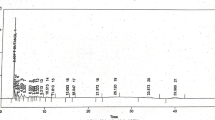Abstract
Among food and agricultural products, spices play important roles in the diets of millions of people worldwide. These products may be colonized by fungi genus and subsequently mycotoxin production. Due to the large demand and supply of spice for cooking, preservative effects, or medicine purpose, it is essential that further investigation is designed to examine mycotoxins in spice. In the present study, the possible contamination of spices by aflatoxins (AFTs) and ochratoxin A (OTA) were analyzed. A total of 80 spice samples (curry, sumac, ginger, and saffron) were purchased and cultured on appropriate medium. Simultaneously mycotoxins from spices were extracted with immunoaffinity columns (IAC), and the occurrence of AFTs (B1 + B2 + G1 + G2) and OTA was then determined using high-performance liquid chromatography (HPLC) with a fluorescence detector (FD). The results depicted that 62 (77.5%) and 58 (72.5%) spice samples were contaminated with AFTs and OTA, respectively. Out of the 80 analyzed spices samples, the mean concentration of AFTs and OTA was higher in the curry samples. Among spices that contaminated with mycotoxins, 5 (6.25%) and 2 (10%) of the samples were above the acceptable limit of AFTs (≥ 10 μg/kg) and OTA (≥ 15 μg/kg), respectively. Aspergillus species were the predominant species isolated, followed by Penicillium, and finally Mucor species.
Among the examined samples, only few curry samples were contaminated with mycotoxins above acceptable limit. Despite this low level of contamination, this spice is used daily in the cuisine of this region of the world, and consequently, even the small amount of these heat stable toxins for a long time may cause many adverse effects. Hence, it is recommended to monitor the toxicogenous fungi contamination and level of mycotoxins in the spices.
Similar content being viewed by others
References
Aiko V, Mehta A (2016) Prevalence of toxigenic fungi in common medicinal herbs and spices in India. 3 Biotech 6(2):159. https://doi.org/10.1007/s13205-016-0476-9
Alshannaq A, Yu J-H (2017) Occurrence, toxicity, and analysis of major mycotoxins in food. Int J Environ Res Public Health 14(6):632. https://doi.org/10.3390/ijerph14060632
Azzoune N, Mokrane S, Riba A, Bouras N, Verheecke C, Sabaou N, Mathieu F (2016) Contamination of common spices by aflatoxigenic fungi and aflatoxin B1 in Algeria. Qual Assur Saf Crops Foods 8(1):137–144. https://doi.org/10.3920/QAS2014.0426
Barac A (2019) Mycotoxins and human disease. In: Clinically Relevant Mycoses. Springer, pp 213–225. https://doi.org/10.1007/978-3-319-92300-0_14
Beyene AM, Du X, Schrunk DE, Ensley S, Rumbeiha WK (2019) High-performance liquid chromatography and enzyme-linked immunosorbent assay techniques for detection and quantification of aflatoxin B 1 in feed samples: a comparative study. BMC Res Notes 12(1):1–6. https://doi.org/10.1186/s13104-019-4538-z
Bokhari FM (2007) Spices mycobiota and mycotoxins available in Saudi Arabia and their abilities to inhibit growth of some toxigenic fungi. Mycobiology 35(2):47–53. https://doi.org/10.1186/s13104-019-4538-z
Campos WE, Rosas LB, Neto AP, Mello RA, Vasconcelos AA (2017) Extended validation of a senstive and robust method for simultaneous quantification of aflatoxins B1, B2, G1 and G2 in Brazil nuts by HPLC-FLD. J Food Compos Anal 60:90–96. https://doi.org/10.1016/j.jfca.2017.03.014
Cho S-H, Lee C-H, Jang M-R, Son Y-W, Lee S-M, Choi I-S et al (2008) Aflatoxins contamination in spices and processed spice products commercialized in Korea. Food Chem 107(3):1283–1288. https://doi.org/10.1016/j.foodchem.2007.08.049
Chuaysrinule C, Maneeboon T, Roopkham C, Mahakarnchanakul W (2020) Occurrence of aflatoxin-and ochratoxin A-producing Aspergillus species in Thai dried chilli. J Agric Food Res 2:100054. https://doi.org/10.1016/j.jafr.2020.100054
Curticapean A, Toma F, Tarcea M, Curticapean M, Samarghitan V, Pop IA, Gulea A (2011) HPLC method validation for simultaneous determination of three mycotoxins from corn seeds. Croat Chem Acta 84(3):413–417. https://doi.org/10.5562/cca1788
Das M, Devi KP (2019) Potential role of curcumin and its derivatives against Alzheimer disease. In: Curcumin for neurological and psychiatric disorders. Elsevier, pp 211–230. https://doi.org/10.1016/B978-0-12-815461-8.00011-6
Duarte S, Lino C, Pena A (2010) Mycotoxin food and feed regulation and the specific case of ochratoxin A: a review of the worldwide status. Food Addit Contam 27(10):1440–1450. https://doi.org/10.1080/19440049.2010.497166
El Darra N, Gambacorta L, Solfrizzo M (2019) Multimycotoxins occurrence in spices and herbs commercialized in Lebanon. Food Control 95:63–70. https://doi.org/10.1016/j.foodcont.2018.07.033
Estiarte N, Crespo-Sempere A, Marín S, Ramos A, Worobo R (2018) Stability of alternariol and alternariol monomethyl ether during food processing of tomato products. Food Chem 245:951–957. https://doi.org/10.1016/j.foodchem.2017.11.078
Ghaffari S, Roshanravan N (2019) Saffron; An updated review on biological properties with special focus on cardiovascular effects. Biomed Pharmacother 109:21–27. https://doi.org/10.1016/j.biopha.2018.10.031
Goryacheva IY, Saeger S d, Eremin SA, Peteghem CV (2007) Immunochemical methods for rapid mycotoxin detection: evolution from single to multiple analyte screening: A review. Food Addit Contam 24(10):1169–1183. https://doi.org/10.1080/02652030701557179
Hammami W, Fiori S, Al Thani R, Kali NA, Balmas V, Migheli Q, Jaoua S (2014) Fungal and aflatoxin contamination of marketed spices. Food Control 37:177–181. https://doi.org/10.1016/j.foodcont.2013.09.027
Hendel E, Ramirez S, Gott P, Raj Murugesan G, Hofstetter U (2020) PSII-22 trends in mycotoxin contamination in United States Corn. J Anim Sci 98(Supplement_3):172–173. https://doi.org/10.1093/jas/skaa054.306
Jeswal P, Kumar D (2015) Natural occurrence of toxigenic mycoflora and ochratoxin A & aflatoxins in commonly used spices from Bihar state (India). J Environ Sci Toxicol Food Technol 9(2):50–55. https://doi.org/10.9790/2402-09215055
Kabak B, Dobson AD (2017) Mycotoxins in spices and herbs–an update. Crit Rev Food Sci Nutr 57(1):18–34. https://doi.org/10.1080/10408398.2013.772891
Kazi M, Nasr FA, Noman O, Alharbi A, Alqahtani MS, Alanazi FK (2020) Development, characterization optimization, and assessment of curcumin-loaded bioactive self-nanoemulsifying formulations and their inhibitory effects on human breast cancer MCF-7 cells. Pharmaceutics 12(11):1107. https://doi.org/10.3390/pharmaceutics12111107
Khazaeli P, Mehrabani M, Heidari MR, Asadikaram G, Najafi ML (2017) Prevalence of aflatoxin contamination in herbs and spices in different regions of Iran. Iran J Public Health 46(11):1540–1545
Linardaki ZI, Lamari FN, Margarity M (2017) Saffron (Crocus sativus L.) tea intake prevents learning/memory defects and neurobiochemical alterations induced by aflatoxin B 1 exposure in adult mice. Neurochem Res 42(10):2743–2754. https://doi.org/10.1007/s11064-017-2283-z
Marchese S, Polo A, Ariano A, Velotto S, Costantini S, Severino L (2018) Aflatoxin B1 and M1: biological properties and their involvement in cancer development. Toxins 10(6):214. https://doi.org/10.3390/toxins10060214
Mogensen JM, Varga J, Thrane U, Frisvad JC (2009) Aspergillus acidus from Puerh tea and black tea does not produce ochratoxin A and fumonisin B2. Int J Food Microbiol 132(2-3):141–144. https://doi.org/10.1016/j.ijfoodmicro.2009.04.011
Motloung L, De Saeger S, De Boevre M, Detavernier C, Audenaert K, Adebo O, Njobeh P (2018) Study on mycotoxin contamination in South African food spices. World Mycotoxin J 11(3):401–409. https://doi.org/10.3920/WMJ2017.2191
Musaiger AO, Al-Jedah JH, D’souza R (2008) Occurrence of contaminants in foods commonly consumed in Bahrain. Food Control 19(9):854–861. https://doi.org/10.1016/j.foodcont.2007.08.011
Mzabri I, Addi M, Berrichi A (2019) Traditional and Modern Uses of Saffron (Crocus Sativus). Cosmetics 6(4):63. https://doi.org/10.3390/cosmetics6040063
O’Riordan MJ, Wilkinson MG (2008) A survey of the incidence and level of aflatoxin contamination in a range of imported spice preparations on the Irish retail market. Food Chem 107(4):1429–1435. https://doi.org/10.1016/j.foodchem.2007.09.073
Orlowski MJ Mr (1991) Mucor dimorphism. 55(2):234–258
Pakshir K, Mirshekari Z, Nouraei H, Zareshahrabadi Z, Zomorodian K, Khodadadi H, Hadaegh A (2020) Mycotoxins detection and fungal contamination in black and green tea by HPLC-based method. J Toxicol 2020. https://doi.org/10.1155/2020/2456210
Pitt J (1988) A laboratory guide to common Penicillium species: CSIRO
Rad AH, Iraji Z, Kafil HS, Servat H (2020) Antioxidant and antimicrobial effect of sumac (Rhus Coriaria L.) powder on E. Coli and penicillim notatum in prebiotics low fat yoghurt. Carpathian J Food Sci Technol 12(1). https://doi.org/10.34302/crpjfst/2020.12.1.4
Razavi B-M, Hosseinzadeh H (2020) Cardiovascular effects of saffron and its active constituents. In: Saffron. Elsevier, pp 451–460. https://doi.org/10.1016/B978-0-12-818638-1.00030-7
Tarazona A, Gómez JV, Mateo F, Jiménez M, Romera D, Mateo EM (2020) Study on mycotoxin contamination of maize kernels in Spain. Food Control 118:107370. https://doi.org/10.1016/j.foodcont.2020.107370
Tesfamariam K, De Boevre M, Kolsteren P, Belachew T, Mesfin A, De Saeger S, Lachat C (2020) Dietary mycotoxins exposure and child growth, immune system, morbidity, and mortality: a systematic literature review. Crit Rev Food Sci Nutr 60:1–21. https://doi.org/10.1080/10408398.2019.1685455
Thanushree M, Sailendri D, Yoha K, Moses J, Anandharamakrishnan C (2019) Mycotoxin contamination in food: an exposition on spices. Trends Food Sci Technol 93:69–80. https://doi.org/10.1016/j.tifs.2019.08.010
van Egmond HP, Jonker MA (2004) Worldwide regulations for mycotoxins in food and feed in 2003. Food and Agriculture Organization of the United Nations
Yunes NB, Oliveira RC, Reis TA, Baquião AC, Rocha LO, Correa B (2019). Effect of temperature on growth, gene expression, and aflatoxin production by Aspergillus nomius isolated from Brazil nuts. gercj:1-8. https://doi.org/10.1007/s12550-019-00380-w
Zain ME (2011) Impact of mycotoxins on humans and animals. J Saudi Chem Soc 15(2):129–144. https://doi.org/10.1016/j.jscs.2010.06.006
Zareshahrabadi Z, Bahmyari R, Nouraei H, Khodadadi H, Mehryar P, Asadian F, Zomorodian K (2020) Detection of aflatoxin and ochratoxin A in spices by high-performance liquid chromatography. J Food Qual 2020:1–8. https://doi.org/10.1155/2020/8858889
Zinedine A, Brera C, Elakhdari S, Catano C, Debegnach F, Angelini S et al (2006) Natural occurrence of mycotoxins in cereals and spices commercialized in Morocco. Food Control 17(11):868–874. https://doi.org/10.1016/j.foodcont.2005.06.001
Availability of data and materials
The datasets used and/or analyzed during the current study are available from the corresponding author on reasonable request.
Funding
This study is part of MSc thesis of Mahdieh Karimirad (grant number: 15504) and financially supported by the Shiraz University of Medical Sciences.
Author information
Authors and Affiliations
Contributions
Conceptualization: Kamiar Zomorodian and Zahra Zareshahrabadi. Methodology: Mahdieh Karimirad and Robab Bahmyari. Formal analysis and investigation: Hasti Nouraei and Marjan Motamedi. Writing—original draft preparation: Zahra Zareshahrabadi. Writing—review and editing: Kamiar Zomorodian and Keyvan Pakshir. Funding acquisition: Kamiar Zomorodian. Resources: Kamiar Zomorodian. Supervision: Kamiar Zomorodian.
Corresponding author
Ethics declarations
Ethics approval and consent to participate
Not applicable.
Consent for publication
Not applicable.
Competing interests
The authors declare no competing interests.
Additional information
Responsible Editor: Lotfi Aleya
Publisher’s note
Springer Nature remains neutral with regard to jurisdictional claims in published maps and institutional affiliations.
Rights and permissions
About this article
Cite this article
Zareshahrabadi, Z., Karimirad, M., Pakshir, K. et al. Survey of aflatoxins and ochratoxin A contamination in spices by HPLC-based method in Shiraz, Southern of Iran. Environ Sci Pollut Res 28, 40992–40999 (2021). https://doi.org/10.1007/s11356-021-13616-z
Received:
Accepted:
Published:
Issue Date:
DOI: https://doi.org/10.1007/s11356-021-13616-z




